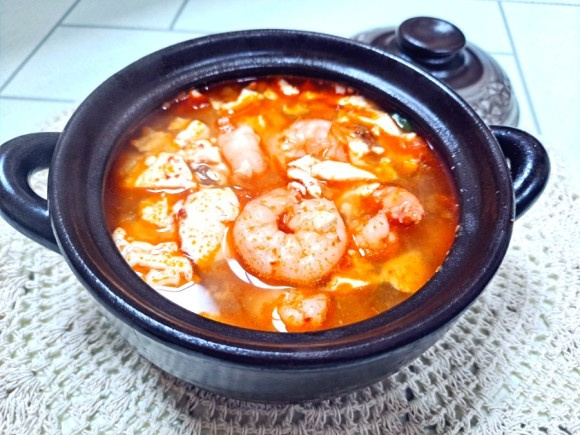Rich Shrimp and Soft Tofu Stew (Sundubu Jjigae)
How to Make Delicious Shrimp Sundubu Jjigae Without Irritating Spices, a Perfect Stew Dish

Today, I’m sharing a recipe for Shrimp Sundubu Jjigae made with a homemade seasoning paste, so it’s not overly spicy and has a comforting depth of flavor. My husband, who isn’t usually a big fan of sundubu jjigae, devoured this one! It’s packed with shrimp and has a delightful texture. Let’s make this comforting and delicious stew together!
Ingredients- 1 pack (approx. 300-400g) soft tofu
- 400ml anchovy-kelp broth (or rice water)
- 100g beef (thinly sliced for bulgogi or ground)
- 20 medium-sized whiteleg shrimp
- 3 Tbsp minced green onion
- 5 Tbsp minced onion
- 2 Tbsp sesame oil
- 2 Tbsp cooking oil
Cooking Instructions
Step 1
We’re going to make a wonderfully rich and flavorful Shrimp Sundubu Jjigae. Although the ingredient list might look long, once you prepare the seasoning paste, this stew is surprisingly simple to put together! First, prepare 400ml of anchovy-kelp broth. Using broth instead of plain water is key to achieving a delicious depth of flavor in your sundubu jjigae.
Step 2
The shrimp I’m using today are whiteleg shrimp from my freezer. They are medium-sized, about the size often used for dishes like Gambas al Ajillo or butter-grilled shrimp. You can also use fresh shrimp if you have them.

Step 3
Finely mince the onion and slice the green onion thinly (about 3 tablespoons worth). Having your vegetables prepped will make the cooking process much smoother.

Step 4
Gently pat dry the beef (100g) with paper towels to remove excess blood, then cut it into small pieces, similar in size to the chopped green onions. You can also use ground pork for a nice flavor, but I’m using leftover beef today.

Step 5
If using frozen shrimp, thaw them in cold water. Then, peel them, remove the heads and tails. Using a toothpick, carefully devein the shrimp by removing the dark line along their backs. Rinse them thoroughly.

Step 6
Now, let’s start stir-frying. Heat 2 tablespoons of sesame oil and 2 tablespoons of cooking oil in a pot over medium heat. Add the minced onion and green onion, and stir-fry until fragrant and they become slightly softened, creating a flavorful ‘green onion oil’.

Step 7
As the onion becomes translucent and the green onions soften, their natural sweetness will enhance the stew’s overall flavor. Once the vegetables are nicely sautéed, add the cut beef. Break up any clumps of meat and stir-fry until it’s mostly cooked through.

Step 8
When the beef is about 80% cooked, add 2 tablespoons of red pepper flakes (gochugaru). Reduce the heat to low and stir-fry for about 1 minute, being careful not to burn the flakes. This step helps to bloom the chili flakes and create a vibrant red chili oil, deepening the stew’s color and flavor.

Step 9
See how beautifully the chili oil has developed? It’s important to keep the heat low at this stage to prevent the gochugaru from burning.

Step 10
Once the chili oil is well-infused, pour in the 400ml of prepared anchovy-kelp broth. Bring it to a boil over high heat, then reduce to medium heat once it starts bubbling.

Step 11
When the broth is boiling, add 1 tablespoon of soy sauce for soup (guk-ganjang) and 3 tablespoons of fish sauce to season. Fish sauce adds a wonderful umami depth, so it’s highly recommended. Let it simmer for a bit longer to allow the flavors to meld.

Step 12
Once the seasoning base is ready, carefully add the shrimp and the soft tofu. You can add the soft tofu in large chunks or break it up gently with a spoon. Be careful not to stir too vigorously, as you want to maintain some texture.

Step 13
The soft tofu I used was quite soft from the package, so even gentle stirring caused it to break apart easily. Try not to over-stir the tofu once it’s in the pot to keep its delicate texture.

Step 14
After adding the tofu and simmering for about 3-5 minutes until the tofu is heated through, taste the stew and adjust the seasoning with more fish sauce if needed. Finally, add the finely chopped cheongyang pepper for an extra kick. Your delicious Shrimp Sundubu Jjigae is now complete!

Step 15
This Shrimp Sundubu Jjigae is perfect for cold winter days or when you crave a warm, comforting bowl of soup! The combination of silky soft tofu, plump shrimp, savory beef, and the spicy broth makes it an irresistible ‘rice thief’ – a dish that makes you want to eat a whole bowl of rice with it!

Step 16
With beef and shrimp, it’s bound to be delicious! The ratio of seasoning to broth is crucial in sundubu jjigae. Since soft tofu releases water as it cooks, adding too much broth initially can make the stew bland. The amount of broth here is just right, so resist the urge to add more!

Step 17
Stir-frying the beef first adds a richer depth to the broth, resulting in an incredibly satisfying Shrimp Sundubu Jjigae! Use this recipe to create a wonderful meal that the whole family will love. I highly recommend it for your next dinner!



